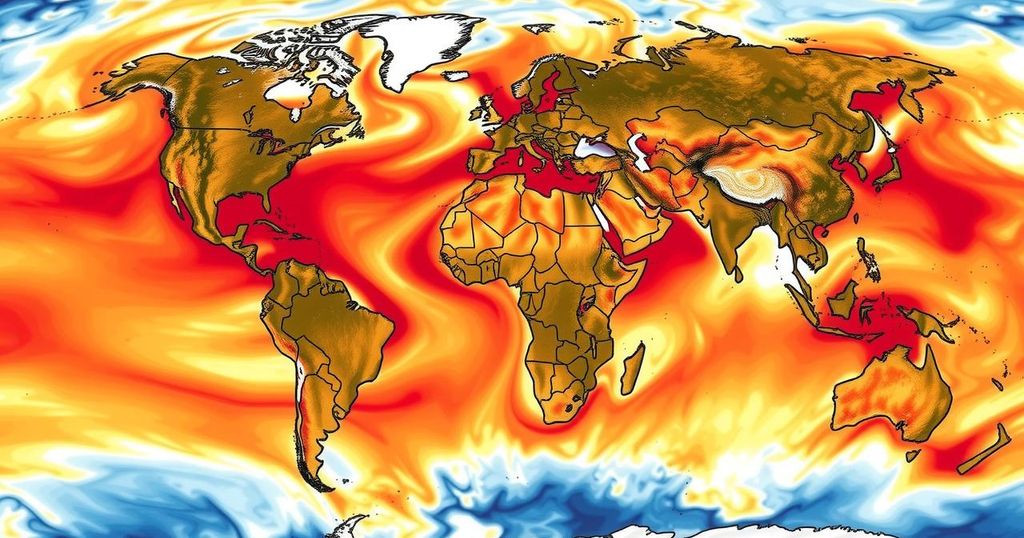Weather
AFRICA, ARCTIC, ASIA, CLIMATE, COPERNICUS, COPERNICUS CLIMATE CHANGE SERVICE, EUROPE, EXTREME WEATHER, FORECAST, GLOBAL WARMING, GREENHOUSE GAS EMISSIONS, NASA, NATIONAL CENTERS FOR ENVIRONMENTAL INFORMATION, NCEI, NOAA, NORTH AMERICA, OCEANIA, SERVICE, SOUTH AMERICA, UK MET OFFICE, WEATHER
Oliver Grayson
0 Comments
Record Heat and Melting Ice: 2024 Declared Warmest Year on Record
2024 has been declared the warmest year on record, marking a 2.32°F increase over the 20th-century average. Antarctic sea ice coverage dipped to the second lowest extent, while upper ocean heat content set a new record high. Additionally, tropical cyclone activity remained average, with notable counts of named storms. These observations underscore escalating climate change concerns and the need for immediate action.
In 2024, the Earth recorded its highest average temperatures ever noted, according to research conducted by scientists at NOAA’s National Centers for Environmental Information (NCEI). This year marked a staggering 2.32 degrees Fahrenheit (1.29 degrees Celsius) rise above the 20th-century average, surpassing the previous warmest year, 2023, by 0.18 degrees Fahrenheit (0.10 degrees Celsius). Notably, all regions including Africa, Europe, North America, Oceania, and South America experienced their hottest recorded temperatures, while Asia and the Arctic noted their second highest. Moreover, global temperature exceeded pre-industrial averages by 2.63 degrees Fahrenheit (1.46 degrees Celsius).
The situation of Antarctic sea ice also depicted alarming trends, with its coverage measured at an average of 4.00 million square miles, marking the second lowest extent ever recorded. Both minimum and maximum extents in February and September, respectively, were also noted as second lowest on record. In contrast, Arctic sea ice extent positioned at 4.03 million square miles, falling within the seventh lowest recorded measurements.
Furthermore, 2024 recorded unprecedented levels of upper ocean heat content, the highest on record since monitoring began in 1958. This indicator reflects the ocean’s role as a significant heat reservoir, absorbing approximately 90% of Earth’s excess heat. The year also witnessed typical global tropical cyclone activity, with 85 named storms, closely aligning with the average count from 1991 to 2020.
For further details about these findings, interested parties are encouraged to refer to NOAA NCEI’s year-end global climate report for 2024, which features comprehensive data and imagery substantiating these observations.
As climate change remains an increasingly pressing issue, the year 2024 has underscored its severe impact through unprecedented temperature rises globally. Scientific organizations have consistently measured and reported on these conditions, noting significant deviations from historical data across the board, particularly in temperature and ice extent metrics. This rise in global temperatures is further compounded by the alarming decline in ice coverage across both the Antarctic and Arctic regions, indicating broader changes in environmental patterns that could have lasting effects on ecosystems worldwide. These developments not only reflect changes in climatic conditions but also highlight the urgency for comprehensive climate action to mitigate further progression of these trends.
In conclusion, 2024 has undeniably emerged as a pivotal year in climate history, marking the highest temperatures recorded since 1850 and revealing critical declines in Antarctic sea ice. The data from NOAA and supporting scientific bodies elucidate significant trends in oceanic heat and storm activity. The continued rise in global temperatures indicates an urgent need for robust climate action to address these alarming changes.
Original Source: www.noaa.gov




Post Comment